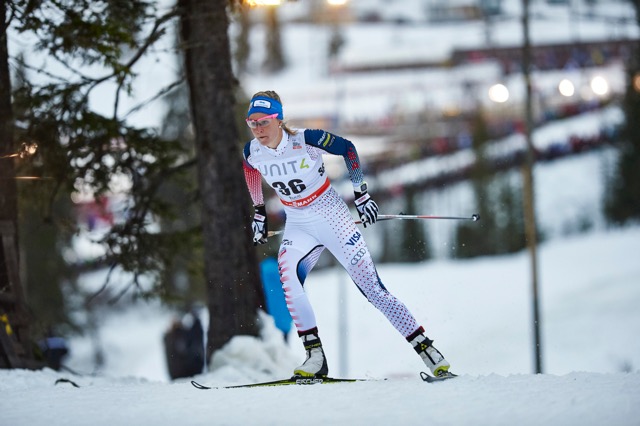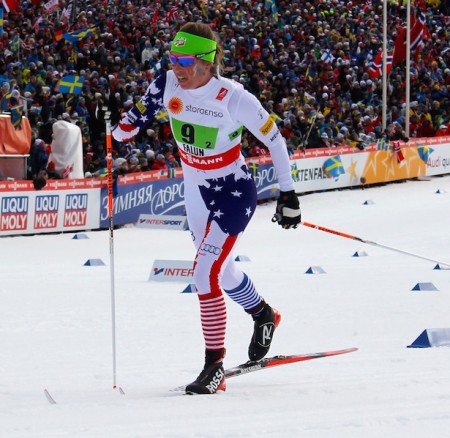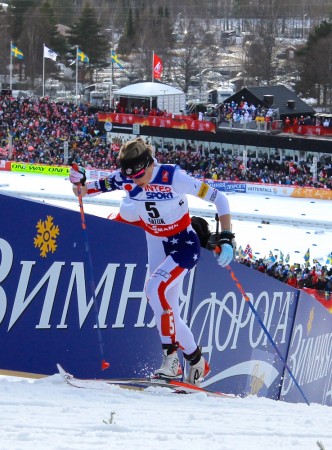
All ski races can be considered a game of balancing strengths and weaknesses, but this is rarely more obvious than in skiathlons. Featuring a technique change halfway through the race, skiathlons are a unique race format that favor versatile racers.
The U.S. women were able to strike this balance on Saturday and end up with four in the top 30 in the 15-kilometer skiathlon at the World Cup in Lillehammer, Norway. Sadie Bjornsen led the U.S. Ski Team women in 20th place (+3:28.2), closely followed by Liz Stephen in 25th (+3:51.7) and Jessie Diggins in 26th (+3:53.2). Caitlin Gregg made the points in 30th (+4:06.3) and Rosie Brennan was about 40 seconds out in 37th.
Norwegian Therese Johaug continued to demonstrate her dominance by winning by nearly a minute and half over her teammate Heidi Weng. Just 0.1. seconds behind Weng, Charlotte Kalla of Sweden claimed the third (+1:29.4).
The skiathlon format featured a 7.5 k classic portion followed by 7.5 k of freestyle. Due to a lack of snow, the skate and classic legs were held on the same 3.75 k lap.
The mid-race technique change poses a challenge for skiers who feel significantly more confident in one technique over another. Both Bjornsen and Brennan consider classic skiing to be their strength.
“In the past, classic technique has been my stronger suite, so it’s always a hard switch for me to go into skating and feel I’m in a league I don’t belong in,” Bjornsen said in a phone after the race. “Today when I switched to skate skis I felt really good and strong and was able to ski with the people I was around so I was pretty stoked about that.”
Although her classic leg was not what Bjornsen was hoping for — she stood in 17th at the ski change — she posted a strong skate leg to finish 20th overall. Her top 20 was on the heels of her 14th overall finish in the Ruka mini tour last weekend. In four World Cup races so far this season, Bjornsen has finished 20th or better in all of them.
“Sadie continued to demonstrate that right now she has the complete package in skating and classic,” U.S. Ski Team Head Coach Chris Grover said on the phone. “She held steady throughout the race, maybe a little stronger in classic. She really just confirmed that last weekend’s results is really where she is at in technique and fitness.”

Brennan explained that, personally, ending with skating can be challenging.
“I am typically a much better classic skier so this format has always been a bit of a mental hurdle for me knowing I have to finish skating,” she wrote, explaining that she tried to start the race faster to compensate. In the skate portion, Brennan conceded just four places, from 34th at the ski change to 37th overall.
The Lillehammer course is notoriously difficult, and the course challenges were compounded by the multiple-lap format. Because both techniques were held on the same lap, the classic tracks were partitioned off which created a narrow course for a mass start race.
“This was our first mass start so it provided good practice skiing in packs and working through tight sections,” Brennan explained. “It was very challenging to pass anyone with just two narrow tracks for much of the loop.”
“It is one of the hardest courses on the World Cup circuit” Grover said. “The course is defined by a tough 700-meter climb racers had to tackle each lap. People have different strategies for how they were going to survive that hill or excel on that hill or save their energy for that hill.”
For Stephen, one thing she wanted to do was “ski like hell on the climbs.” This mission was accomplished, in addition to her goal of finishing in the top 30 to earn World Cup points for the first time this season.
Thirty-sixth and 2:12 back from race leader Johaug at the halfway point, Stephen skated her way up to 25th over the second half of race.

“Classic is a really big work in progress for me so I am always excited to make the switch to skating,” Stephen said on the phone.
She considered her result “a good step up from last weekend so that’s a good feeling,” she said. At last weekend’s Ruka Triple, she placed 59th overall.
“I know there is a lot more to come and I have a lot more expectations than I was able to fulfill, but it is also a really long season,” Stephen said. “I feel good about where my energy is and I know I’ve trained really hard so I’m being patient.”
For the team’s skating powerhouses, the plan was mostly to stay in contention during the classic leg and attack the second half. However, for Diggins and Gregg, both World Championships medalists in the 10 k freestyle, their classic legs turned out to be pleasant surprises. Gregg was 29th at the transition, 1:57 behind the leader, and Diggins was in 33rd, eight seconds out of 30th and 2:07 back.
Grover cited Gregg’s classic leg as one of the highlights of the day. “It was really a step forward with her technique and her fitness has been great all year,” he said.
“My classic leg felt really good today. I would say it felt better than my skate at times,” Gregg wrote in an email. “Both were a solid step in the right direction and I feel like I will continue to improve.”
Diggins also saw her classic leg as definite progress.
“I think my classic skiing took a step forward with all the steep hills from where it was last year,” Diggins wrote in an email. “I worked my way up a few places in the skate half and I had really great skis today in both techniques. My body was a bit tired and I’ll be doing a little more recovery training next week to prepare for [the World Cup in] Davos.”
“It’s really fun to have the girls finishing in the top 30,” Bjornsen said. “It’s nice that everyone is starting to feel like themselves and it makes me really excited for tomorrow. It should be a really fun day and the Norwegian vibe around here is always amazing with the amount of cheering.”
Bjornsen will start second for the U.S. in the women’s 4 x 5 k relay on Sunday, after Brennan leads the team out in the first of two classic legs. Stephen will ski the first skate leg, and Diggins will anchor.
Canada’s lone female in Lillehammer, Emily Nishikawa placed 52nd (+7:11.9) after ranking 46th at the end of the classic leg.



